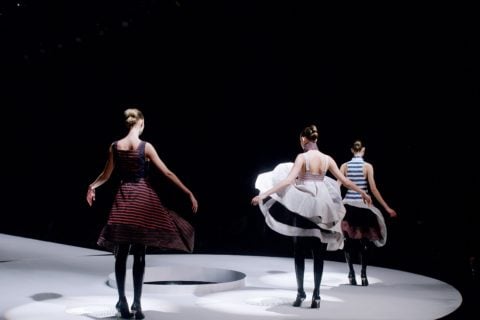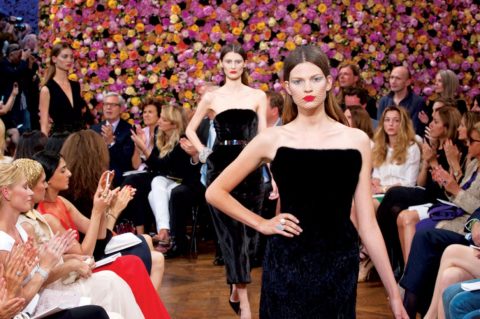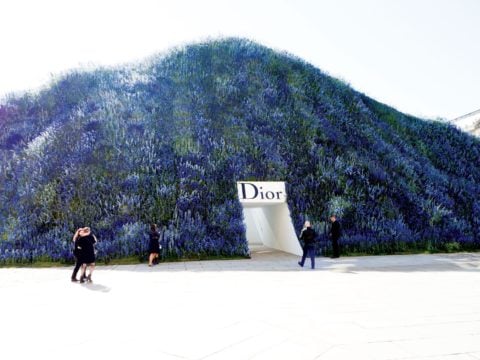Alexandre de Betak Set the Scene for All Your Favourite Shows and Designers
In the seconds before one of Alexandre de Betak’s runway productions begins, his voice usually comes on the loudspeaker with the same polite request for the guests seated in the front row: “Ladies and gentlemen, uncross your legs, please.” Depending on the city, he makes this announcement in his native French or in a refined, barely accented English. Fashion show habitués might say that this is the most obvious identifier in his high-impact approach to setting the scene for directional designers and brands such as Christian Dior, Calvin Klein, Rodarte, Mary Katrantzou, Hussein Chalayan, Viktor & Rolf, H&M and Jacquemus.
But once the lights go up and guests’ shoes are safely outside the photographers’ frames, the Bureau Betak influence truly takes shape. Whatever the creative direction of a collection, de Betak adapts and makes magic. When asked whether guests can detect his stylistic DNA, he only says, “Whether special effects or pure minimalism, I think there’s a way of using those chosen elements that make it a very de Betak signature.”
By the time you read this article, de Betak will have surpassed an extraordinary milestone: 1,000 runway shows and presentations produced around the world over the better part of three decades. Odds are, if you have attended a show in one of the four fashion capitals, you have experienced the ever-changing ways in which he conjures up atmospheres—from a vaguely retro explorer theme accented with global flora and life-size cardboard-sculpted fauna for the recent Dior haute couture show to the fluorescent tube lighting that reappears season after season on Rodarte’s runways. But you don’t need an invitation from these brands to watch de Betak’s spectacles; they have evolved in theatricality alongside technological advances such as live streaming so that anyone can feel the frisson of the front row from their smartphones.
Indeed, de Betak’s new, seriously slick monograph, Betak: Fashion Show Revolution (released this past October), confirms that this Paris- and New York-based creative mastermind and his namesake agency of roughly 50 staff deserve significant credit for transforming the conventional défilé into what is arguably the most anticipated, pivotal and engaging aspect of a brand’s or designer’s ongoing identity. Starting with an introduction by Sally Singer, creative digital director for Vogue.com, and ending with comments by huge names from both inside and outside the industry (think Raf Simons, Michael Kors and Kirsten Dunst), the book lays out the larger-than-life sets, conceptual artistry and special effects that induce awe—even among the most jaded fashion types.
But as the industry’s inherent excitement gets increasingly weighed down by the challenges of off-calendar scheduling, untested cycles (see now, buy when?) and the constant expectation of shaking up the system, the onus falls more and more on de Betak to make something magical and memorable out of a mere 10 minutes—15 max. He acknowledges as much when we speak by phone, while remaining unfazed by the unknowns.
“I started my career addressing a very knowledgeable yet blasé audience of specialized press. And now you still have them, but you also have the direct viewer and somewhat direct consumer. Beyond that, and, more importantly, today, this is forcing the speed at which the new revolution of fashion shows has to happen. Digital media and social media have shown the brands that the viewer has changed and the traditional press is no longer the authority—that expectations are much faster and much wider,” he says, clearly aware of the changing landscape.
The current challenge, he suggests, is to be simultaneously exclusive and inclusive. “Before, when I did fashion shows, I was always thinking of the inspiration of the season as well as the history of the house,” he says. “Now, in addition to these two obvious objectives, we need to address a very wide range of audiences—wide in age, geography and sociological provenances—and give them a wider point of view, a wider range of emotion, something much less dictated by the house and much more raw. People want to see behind the scenes; they want to see what happens and why it happens.”
But won’t all this access kill the cachet? Not when tackled innovatively, de Betak argues. “[Fashion weeks] still need to surprise, and I think the format has become too expected and not surprising enough,” he maintains, adding, “I think there is going to be a full freedom of ways; soon enough, houses will have the freedom of showing when they have to in the commercial cycles but also when they want and where they want because they are showing to everyone, regardless, all the time.”
When I suggest that this is optimistic, he replies: “I’m idealistic and, I think, realistic. I believe that fashion shows are still a medium that makes people dream and helps fashion and luxury brands. I believe that the emotion that comes out of the live momentum is irreplaceable, but I also think there have been too many of them and [they’re] too close together. Not everyone agrees with this, but the traditional audience is no longer the one that matters the most. The live show will still have a reason for existing, but [it needs] to reinvent itself.”
At this point, de Betak, 49, isn’t contemplating his own reinvention so much as brand extension. (Somewhat related, earlier this year, Sofía Sanchez de Betak, his Argentinian art director and fashion consultant wife, released Travels with Chufy: Confidential Destinations, a book whose title is a nod to her well-known nickname.) Complementing his book (which is nearly 300 pages) is a range of “fashion show tools” and “survival gear” that includes pouches made by Comme des Garçons and a special Caviar Kaspia box set containing vodka and a tin of caviar (the restaurant is a legendary hangout during Paris Fashion Week), plus less-decadent items such as sweatshirts, notepads and headphones—all of which were developed by de Betak and launched at Colette for the September shows.
De Betak’s prophecy of what we might expect from fashion shows in the near future reads rather safe, for someone so plugged into the industry. “The basic elements of live human beings walking will, at least to a certain degree, always be there, and the ways they are transmitted and seen and used will be drastically different,” he says. “I think it will be a mix of both extremes; I’m pretty sure of that.” Given that de Betak is already working with some brands on their strategies through summer 2018, can he envision himself still going at this rate well beyond that? “I mean, yes and no,” he answers. “I’m committed to creating the next revolution. And then we’ll see.” After all, at the risk of sounding clichéd, the shows must go on.
See some of our favourite de Betak runway shows and the concepts behind them below.
The post Alexandre de Betak Set the Scene for All Your Favourite Shows and Designers appeared first on FASHION Magazine.



